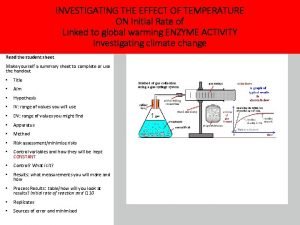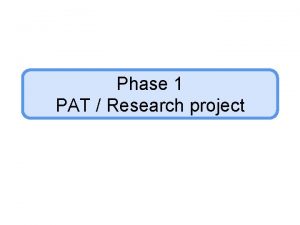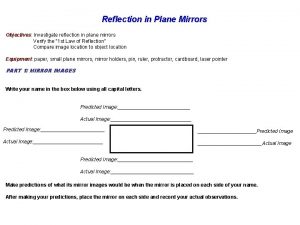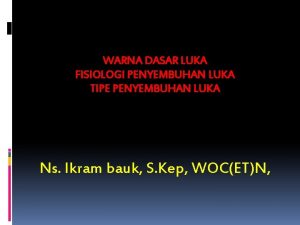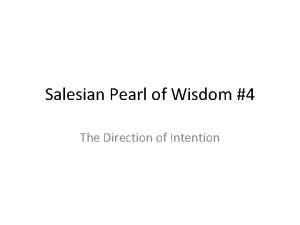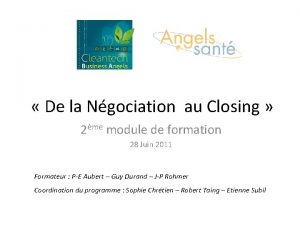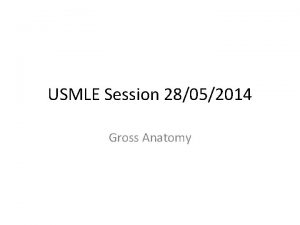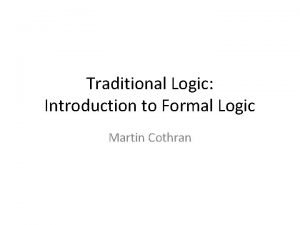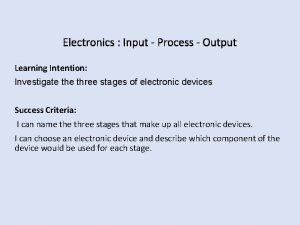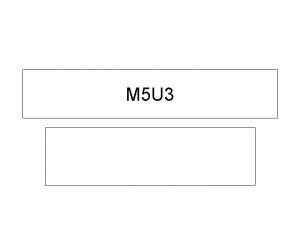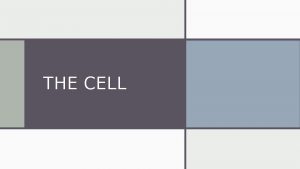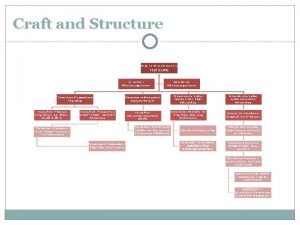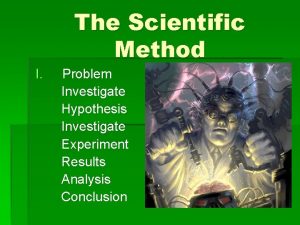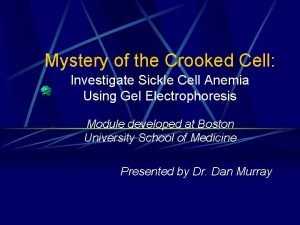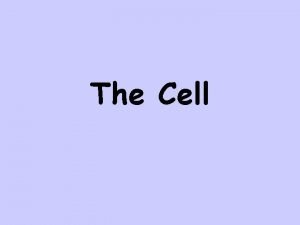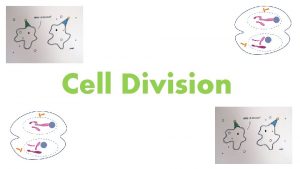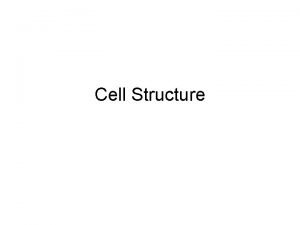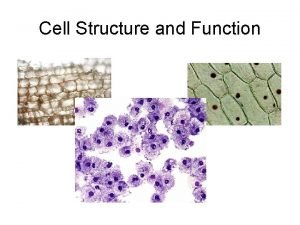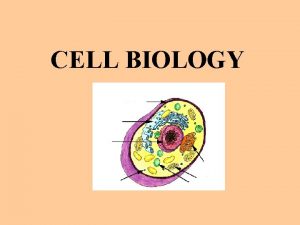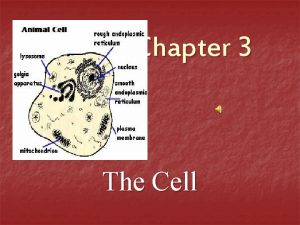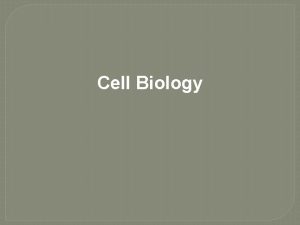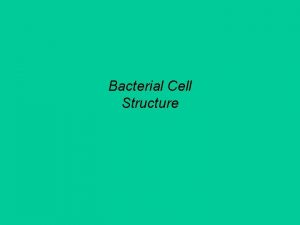Cell structure Learning Intention Investigate the structure of









































































- Slides: 73

Cell structure Learning Intention: Investigate the structure of plant, animal, fungal and bacterial cells. Success Criteria: Be able to identify the main structures found in typical plant and animal cells Be able to identify the main structures found in typical fungal and bacterial cells Be able to state the functions of these structures Be able to do calculations concerning cell size and cell growth

Starter Activity: Answer the following question in your jotter. 1. Name three types of cells in your body. 2. Approximately how many cells are there in the human body? 3. How many cells are there in an Amoeba?

Answers 1. Blood, nerve, muscle, bone, brain, liver, skin etc 2. 100 trillion (100 million) 3. One

UNIT ONE CELL BIOLOGY NATIONAL 5 BIOLOGY

Key Area 1 Cell structure

Animal and plant cells Learning Intention: To review cell structure Success Criteria: • Be able to name the structures common to animal and plant cells which are visible under a light microscope. • Be able to name the structures found only in plant cells which are visible under a light microscope. • Be able to label these on a diagram and state their functions. • Be able to calculate cell size from a picture.

What is a cell? • The following video clips will introduce you to the basic features of cells. What is a cell? (BBC) Plant and animal cell structures (BBC) What is a cell? (Glow)

Examining Onion Cells Aim: To observe and draw onion cells using a microscope. Equipment: • Glass slide • Cover slip • Onion skin • Iodine stain • Microscope • Lamp

Method: • • Collect a thin piece of onion skin. Spread the skin on a slide. The skin must not overlap. Stain the cells by adding 2 drops of iodine stain. Place a cover slip over the skin. Use a pencil or mounted needle to lower the cover slip gently so the air is pushed out. Examine the cells under low then medium power. You should be able to see lots of cells arranged like bricks in a wall. Adjust the microscope to a higher power. Draw exactly what you see through the “field of view” using a pencil. Label as many structures as you can see.

Onion cells in iodine nucleus cell wall cytoplasm

Examining Pondweed Cells Aim: To observe and draw pondweed cells using a microscope. Equipment: • Glass slide • Cover slip • Small leaf from Elodea or Cabomba • Microscope • Lamp

Method: • Collect a small leaf of pondweed. • Place it in a drop of water on a slide. • Use a pencil or mounted needle to lower the cover slip gently so the air is pushed out. • Examine the cells under low then medium power. You should be able to see lots of cells arranged like bricks in a wall. Look for green chloroplasts inside the cells. • Adjust the microscope to a higher power. • Draw exactly what you see through the “field of view” using a pencil. • Label as many structures as you can see. • Return the slide and pack your microscope away carefully.

Pondweed cells • These cells are from a pondweed called Elodea. • These cells are from a pondweed called Cabomba. What two plant cell structures can you see in the pictures?

Other plant cells • These cells are from a beetroot. The red dye makes it hard to see the nucleus but if you look closely you will see them. • These are the cells in the stem of a plant. Some of these cells carry water upwards to the leaves, while others carry sugars from the leaves to other parts of the plant.

A Typical Plant Cell vacuole nucleus cell membrane cell wall green chloroplast cytoplasm

Cell size calculation 0. 5 m m • The field of view in this picture is 0. 5 mm wide. • Calculate the width of one cell (clue: count the number of cells from one side to the other across the line shown). • Now estimate the cell length.

Examining Cheek Cells Aim: To make a slide of cheek cells and draw them. Equipment: • Glass slide • Cover slip • Cotton bud • Methylene blue stain • Microscope and lamp • Paper towel

Method: • Rub the cotton bud over the inside of your cheek to remove some of the cells. • Wipe the cotton bud over the surface of a glass slide. • Place the cotton bud in disinfectant. • Stain the cells with 2 drops of methylene blue stain. • Remove some of the stain using paper towel. • Use a mounted needle to lower the cover slip so the air is pushed out. • Draw the cells and label the structures. • Once you have finished, place the slide and cover slip in disinfectant. • Pack away your microscope carefully.

Cheek cells in methylene blue nucleus cell membrane cytoplasm

Typical Animal Cell nucleus cytoplasm cell membrane

Cheek cell size calculation • The field of view in this picture is 200 µm. (1 mm=1000 µm) 200 µm • Estimate the size of these cheek cells. (Clue : how many would fit across the line? )

Comparison of Cell Types Copy the table and put a tick or a cross in each box. (Answers on next slide) Structure cell wall cell membrane nucleus cytoplasm chloroplasts vacuole Plant Cell Animal Cell

Comparison of Cell Types Structure Plant Cell Animal Cell cell wall yes no cell membrane yes nucleus yes cytoplasm yes chloroplasts yes no vacuole yes no

Functions of cell structures Magnified cell structures (BBC) • Each cell structure has a different job within the cell. This is called its function. • Copy the table on the next slide which summarises the functions of the main structures in plant and animal cells.

Structure Nucleus Cell Membrane Cytoplasm Cell Wall Description Large round structure containing genetic material Very thin layer surrounds the cytoplasm Function Controls cell activities Controls the passage of substances into and out of the cell Fluid, jelly-like material Site of biochemical reactions Outer layer made of mesh of Provides plant cells with cellulose fibres support Stores water and minerals and Vacuole Fluid-filled sac in the cytoplasm provides extra support for plant Chloroplasts Disk-like structures containing Trap light energy for making green chlorophyll food by photosynthesis

Animal and plant cells Learning Intention: To review cell structure Success Criteria: • Be able to name the structures common to animal and plant cells which are visible under a light microscope. • Be able to name the structures found only in plant cells which are visible under a light microscope. • Be able to label these on a diagram and state their functions. • Be able to calculate cell size from a picture.

Starter Activity:

Starter Activity: E C

Cell ultrastructure Learning Intention: To investigate more detailed structures in plant and animal cells Success Criteria: Be able to state that cell structures can be seen clearer and at higher magnification using an electron microscope Be able to name some structures in animal and plant cells which are visible under an electron microscope Be able to label these on a diagram and state their functions

The History of Microscopes The history of microscopes (Glow)

Electron microscopes • Light microscopes like the ones in the lab can magnify up to 400 times. Some light microscopes can magnify up to 1000 times. • Electron microscopes use a beam of electrons instead of light. Some can magnify up to 2 million times. • This allows us to see other smaller structures inside cells.

Light microscope v electron microscope • Image of pollen grains under the light microscope • Image of pollen grains under the electron microscope

High magnification images of pollen using electron microscope

Animal cell under electron microscope • Many new structures can be seen in the cytoplasm that are not seen using a light microscope.

Plant cells under electron microscope What is a cell? (Glow)

Cell ultrastructure • In the cytoplasm of plant and animal cells there are structures called mitochondria. • They are the site of aerobic respiration.

Mitochondria

Nucleus • The nucleus is made up of many chromosomes. • These are not normally seen very clearly as they wound up around each other like a ball of string. • They are made of DNA and are the genetic material of the cell. • How many chromosomes are in each human cell?

Ribosomes • Even smaller structures can be seen in the cytoplasm called ribosomes. • They are the site of protein synthesis in plant, animal and bacterial cells.

Ribosomes (attached to a membrane) (free floating) • Ribosomes can be found free floating, or attached to membranes in the cell.

Cell membrane • The cell membrane can be seen in more detail when using the electron microscope.

Plant cell walls Cellulose fibres When viewed with an electron microscope, the cell wall of plant cells can be seen to be made up of fibres of a material called cellulose. Small molecules can easily pass through the spaces between the fibres.

Cell ultrastructure Label the handout diagram using these words : • nucleus • cytoplasm • ribosomes • mitochondria • chromosomes

Functions of cell structures • Match up the cell structures with their function. • Draw a table, with headings, to display this information. Use a ruler! ribosomes Site of aerobic respiration chromosomes Site of protein synthesis Made of DNA. Contain genetic material of the cell. mitochondria

Cell ultrastructure Learning Intention: To investigate more detailed structures in plant and animal cells Success Criteria: Be able to state that cell structures can be seen clearer and at higher magnification using an electron microscope Be able to name some structures in animal and plant cells which are visible under an electron microscope Be able to label these on a diagram and state their functions

Starter Activity:

Starter Activity: C

Starter Activity: Answer the following question in your jotter. 1. a) What cell structures are made of DNA? b) How many of these are there in a normal human body cell? 2. What is the function of ribosomes? 3. Where in the cell are mitochondria found? 4. Which are the smallest – chromosomes, ribosomes or mitochondria? 5. What kind of microscope is needed to see these clearly?

Answers 1. 2. 3. 4. 5. a) Chromosomes b) 46 Protein synthesis In the cytoplasm Ribosomes Electron microscope

Fungal and bacterial cells Learning Intention: To investigate the structure of fungal and bacterial cells Success Criteria: Be able to name the structures found in fungal cells which are visible under a microscope Be able to label these on a diagram Be able to name the method of reproduction in yeast Be able to name the main structures found in bacterial cells Be able to state the function of plasmids Be able to do calculations of cell growth

Fungal cells • Fungi are a group of organisms that includes mushrooms, moulds, yeast and toadstools. • Yeast is a unicellular fungus – made of single cells. • It has cytoplasm, a nucleus and a cell wall like plant cells. • It has no chloroplasts and cannot photosynthesise. • It reproduces by ‘budding’. • Yeast cells can reproduce rapidly if they have a source of food (sugar)and a suitable temperature.

Looking at yeast Collect the following: • Microscope, slide, yeast suspension, dropper, cover slip. Method • Place one drop of yeast suspension in the middle of a microscope slide, and lower on a cover slip. • View the yeast cells at low and high power. Look for cells that are budding. Small bud forming Yeast cell

Yeast cells under the microscope

Typical fungal cell

Yeast budding ( a method of reproduction) • Copy the diagram. yeast cell

Uses of Yeast Brewing Industries Alternative Fuel Industries Bread-making Industries

Bacterial cells • Bacterial cells are very tiny compared to other plant and animal cells. Viruses are even smaller!

Looking at bacterial cells • Your teacher will give you prepared slides of bacterial cells to view under the microscope. • They have been stained to show them up more clearly. • You will need to use the highest power of lens to see them clearly. • Start by focusing at low power, then increase to medium power then high power.

Structure of a typical bacterial cell • Here you can see that bacterial cells have some of the structures we have already seen in plant and animal cells. • These details can only be seen under electron microscope.

Structure of a typical bacteria cell membrane cell wall Copy the cytoplasm diagram, labels and notes below. main DNA ring (single chromosome) plasmid (additional DNA) flagellum for movement (not always present) • The DNA in bacteria is not in a proper nucleus. • Instead it consists of a main ring or coil of DNA. • In addition to this, there are other smaller rings of DNA called plasmids. • Plasmids are involved in bacterial reproduction.

Cell Wall Structure • The cell walls that surround plant cells are made of cellulose fibres. • The cell walls that surround bacterial cells and fungal cells are not made of cellulose!

Reproduction in yeast and bacterial cells • Single celled organisms like yeast and bacteria reproduce by dividing into two cells. • If the conditions are right, yeast and bacterial cells can divide to make two cells once every 30 minutes. This means that the number of cells can double every 30 minutes! • What do you think would be the ideal conditions for this to happen? Answer : Source of food, suitable temperature, oxygen available

REPRODUCTION IN YEAST AND BACTERIAL CELLS 30 mins 1 hour 30 mins 2 hours 30 mins 1 hour

Yeast dividing calculation • One yeast cell is placed in a sugar solution. It divides to form 2 cells in 30 minutes. How many yeast cells will there be after 12 hours? • How to work it out 12 hours = 24 divisions • Number doubles each division The answer is on the next slide!

1. 2. 3. 4. 5. 6. 7. 8. 9. 10. 11. 12. 13. 14. 15. 16. 17. 18. 19. 20. 21. 22. 23. 24. 2 4 8 16 32 64 128 256 512 1024 2048 4096 8192 16384 32768 65536 131072 262144 524288 1048576 2097152 4194304 8388608 16777216 Answer = 16, 777, 216 yeast cells

Cell variety • We have looked at the structure of typical animal, plant, fungal and bacterial cells. However, not all animal cells look the same. • The same is true of plant, fungal and bacterial cells. • The structure of each type of cell is related to its function. Bioviewer activity • Examine the biosets provided on cell variety. • Read the notes that go with each slide. Types of cells (Glow)

Cell variety challenge • Your challenge is to use your biological knowledge to identify plant, animal, fungal and bacterial cells. • Examine each of the microscope slides under the microscope. Do not uncover the label. • Look at the structures that are visible at low and high power. • Decide whether the cells are animal, plant, fungal or bacterial. • Write down the evidence that led you to your decision. • Reveal the label to find out what each type of tissue is.

Cell variety challenge Copy the table Slide Plant/animal/ Evidence fungal/bacterial A B C D E Name of tissue


C

Fungal and bacterial cells Learning Intention: To investigate the structure of fungal and bacterial cells Success Criteria: Be able to name the structures found in fungal cells which are visible under a microscope Be able to label these on a diagram Be able to name the method of reproduction in yeast Be able to name the main structures found in bacterial cells Be able to state the function of plasmids Be able to do calculations of cell growth

Cell Variety Challenge Your task is to produce an A 5 information booklet about cell structure and function. You must include… q Labelled diagrams of the four main cell types: - Plant – Animal – Bacterial - Fungal q Describe the functions (jobs) of each labelled part. You should include… q Examples of specialised cells from each of the four cell types. q Draw labelled diagrams of your examples and add information about how their special features make them well suited to their special functions. You could include… q A set of ten questions at the back of your booklet about the information inside. To help you gather information with this task you may use any text book in the classroom (Int. 2, higher) and the books in the library cupboard and box. You may also use the Bioviewer slide packs and can have 10 minutes per pair on the computers for research.

Cell Variety Challenge Your task is to produce an A 5 information booklet about cell structure and function. You must include… q Labelled diagrams of the four main cell types: - Plant – Animal – Bacterial - Fungal q Describe the functions (jobs) of each labelled part. You should include… q Examples of specialised cells from each of the four cell types. q Draw labelled diagrams of your examples and add information about how their special features make them well suited to their special functions. You could include… q A set of ten questions at the back of your booklet about the information inside. To help you gather information with this task you may use any text book in the classroom (Int. 2, higher) and the books in the library cupboard and box. You can have 10 minutes each on a computer.
 Verbs for learning intentions
Verbs for learning intentions Learning intention examples
Learning intention examples Learning intention examples
Learning intention examples Summarising learning intention
Summarising learning intention Lesson 4 parameters and return make
Lesson 4 parameters and return make What does oedipus ask creon
What does oedipus ask creon Inital rate
Inital rate How to investigate a problem
How to investigate a problem Investigate bivariate measurement data
Investigate bivariate measurement data Investigate reflection
Investigate reflection Cuadro comparativo e-learning y b-learning
Cuadro comparativo e-learning y b-learning Tipe penyembuhan luka
Tipe penyembuhan luka God give me direction
God give me direction Direction of intention prayer
Direction of intention prayer Intention attention attitude
Intention attention attitude Fausse analogie exemple
Fausse analogie exemple Lettre déclaration d'intention mariage
Lettre déclaration d'intention mariage Lettre d'intention modèle
Lettre d'intention modèle Creative intention meaning drama
Creative intention meaning drama Intention to create legal relations definition
Intention to create legal relations definition The intention to act entrepreneurially
The intention to act entrepreneurially Going to is used for plans, decisions and intentions.
Going to is used for plans, decisions and intentions. How to write a statement of intention vce english
How to write a statement of intention vce english Direction of intention
Direction of intention God give me direction
God give me direction Bargaining strategies
Bargaining strategies Essential tremor vs intention tremor usmle
Essential tremor vs intention tremor usmle Simple apprehension
Simple apprehension Study population
Study population Tissue repair
Tissue repair Intention to learn
Intention to learn Hát kết hợp bộ gõ cơ thể
Hát kết hợp bộ gõ cơ thể Ng-html
Ng-html Bổ thể
Bổ thể Tỉ lệ cơ thể trẻ em
Tỉ lệ cơ thể trẻ em Chó sói
Chó sói Tư thế worms-breton
Tư thế worms-breton Bài hát chúa yêu trần thế alleluia
Bài hát chúa yêu trần thế alleluia Các môn thể thao bắt đầu bằng tiếng chạy
Các môn thể thao bắt đầu bằng tiếng chạy Thế nào là hệ số cao nhất
Thế nào là hệ số cao nhất Các châu lục và đại dương trên thế giới
Các châu lục và đại dương trên thế giới Công thức tiính động năng
Công thức tiính động năng Trời xanh đây là của chúng ta thể thơ
Trời xanh đây là của chúng ta thể thơ Cách giải mật thư tọa độ
Cách giải mật thư tọa độ 101012 bằng
101012 bằng Phản ứng thế ankan
Phản ứng thế ankan Các châu lục và đại dương trên thế giới
Các châu lục và đại dương trên thế giới Thơ thất ngôn tứ tuyệt đường luật
Thơ thất ngôn tứ tuyệt đường luật Quá trình desamine hóa có thể tạo ra
Quá trình desamine hóa có thể tạo ra Một số thể thơ truyền thống
Một số thể thơ truyền thống Cái miệng bé xinh thế chỉ nói điều hay thôi
Cái miệng bé xinh thế chỉ nói điều hay thôi Vẽ hình chiếu vuông góc của vật thể sau
Vẽ hình chiếu vuông góc của vật thể sau Thế nào là sự mỏi cơ
Thế nào là sự mỏi cơ đặc điểm cơ thể của người tối cổ
đặc điểm cơ thể của người tối cổ V cc cc
V cc cc Vẽ hình chiếu đứng bằng cạnh của vật thể
Vẽ hình chiếu đứng bằng cạnh của vật thể Vẽ hình chiếu vuông góc của vật thể sau
Vẽ hình chiếu vuông góc của vật thể sau Thẻ vin
Thẻ vin đại từ thay thế
đại từ thay thế điện thế nghỉ
điện thế nghỉ Tư thế ngồi viết
Tư thế ngồi viết Diễn thế sinh thái là
Diễn thế sinh thái là Dot
Dot Số nguyên là gì
Số nguyên là gì Tư thế ngồi viết
Tư thế ngồi viết Lời thề hippocrates
Lời thề hippocrates Thiếu nhi thế giới liên hoan
Thiếu nhi thế giới liên hoan ưu thế lai là gì
ưu thế lai là gì Hươu thường đẻ mỗi lứa mấy con
Hươu thường đẻ mỗi lứa mấy con Khi nào hổ con có thể sống độc lập
Khi nào hổ con có thể sống độc lập Hệ hô hấp
Hệ hô hấp Từ ngữ thể hiện lòng nhân hậu
Từ ngữ thể hiện lòng nhân hậu Thế nào là mạng điện lắp đặt kiểu nổi
Thế nào là mạng điện lắp đặt kiểu nổi Cell city project animal cell
Cell city project animal cell






